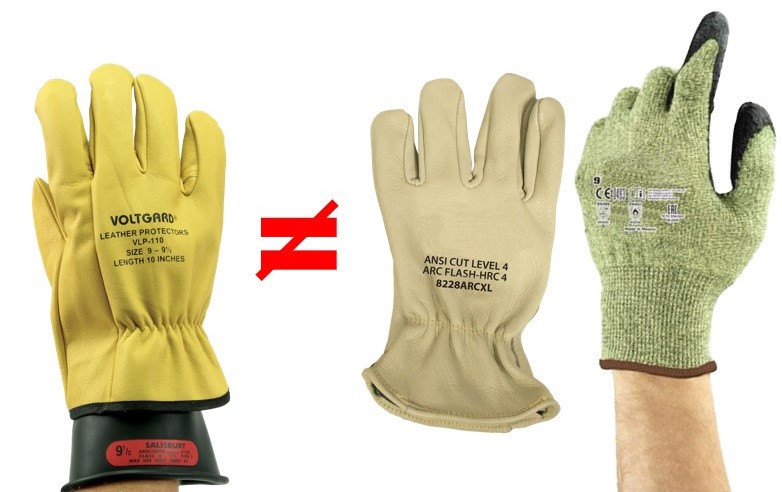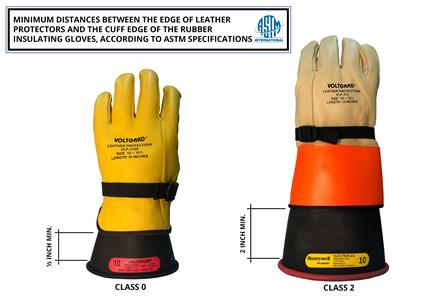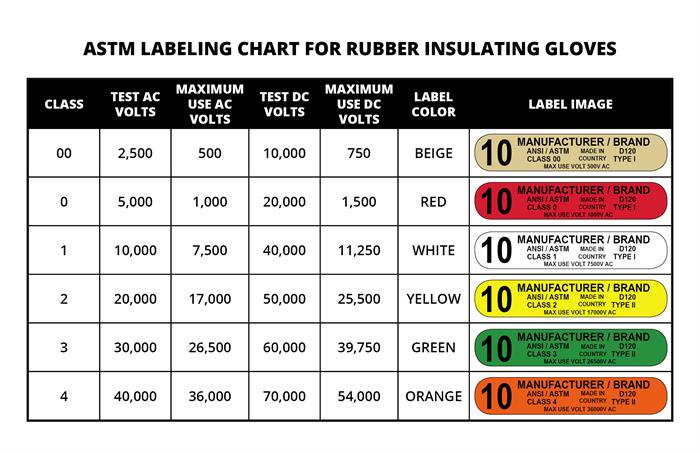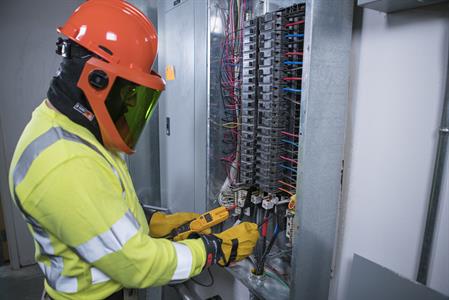Arc Flash Gloves vs. Rubber Insulated Electrical Gloves: What’s the Difference and Which One Should I Use?

Working on electrical systems and performing electrical tasks, whether a line-worker on the outside or electrician inside a production facility, is no doubt dangerous work. Knowledge and personal protective equipment (PPE) can be an electrical worker’s best friends when performing the high-risk tasks required in this trade. With your “life on the line” every day, knowledge of the key hazards present and the PPE available to mitigate those hazards is of the utmost importance, as is selection of the proper PPE needed for the task to be performed. Employees who work on electrically energized circuits and equipment use their hands, making them the most susceptible part of the body to electric shock. Rubber insulating gloves (electrical gloves) are the only protective gear designed for constant contact with, and protection from, energized conductors and equipment. All other items are designed for protection from accidental, incidental or brush contact, and arc-rated work gloves alone provide no protection from voltage. This blog article will focus on the differences between arc flash gloves and rubber insulated electrical gloves and how to choose the correct glove for the application.
Hazards
 Let’s start with the main two hazards at “hand” in doing electrical work. First, there’s electrical shock. This is an unpleasant sensation that occurs when someone has made direct contact with an energized source, resulting in current passing through the body. Electric shock can range from minor to severe with associated injuries ranging from a slight tingle to cardiac arrest or even full-blown electrocution/death. The second hazard is an arc flash. An arc flash is a highly dangerous electrical explosion or uncontrolled release of energy that occurs during an electric fault with current flowing through the air between two live conductors. An arc flash can generate extreme heat, up to 35,000 degrees Fahrenheit. This is three times hotter than the surface of the sun. To say the least, pretty serious stuff. While the causes of arc flashes can be many, some examples are corrosion, dust, animals, dropped tools, electrical equipment failure, insulation damage, damaged wires, and accidental contact.
Let’s start with the main two hazards at “hand” in doing electrical work. First, there’s electrical shock. This is an unpleasant sensation that occurs when someone has made direct contact with an energized source, resulting in current passing through the body. Electric shock can range from minor to severe with associated injuries ranging from a slight tingle to cardiac arrest or even full-blown electrocution/death. The second hazard is an arc flash. An arc flash is a highly dangerous electrical explosion or uncontrolled release of energy that occurs during an electric fault with current flowing through the air between two live conductors. An arc flash can generate extreme heat, up to 35,000 degrees Fahrenheit. This is three times hotter than the surface of the sun. To say the least, pretty serious stuff. While the causes of arc flashes can be many, some examples are corrosion, dust, animals, dropped tools, electrical equipment failure, insulation damage, damaged wires, and accidental contact.
Standards
There are two key standards to understand regarding this topic:
- ASTM D120: Standard Specification for Rubber Insulating Gloves. This standard covers the manufacturing and testing requirements of rubber insulating gloves for protection of workers from electric shock. Within this standard, it outlines testing parameters for six different classes of gloves (00,0,1,2,3 and 4) for use against electric shock depending upon the system voltage present.
- ASTM F2675: Standard Test Method (not specification) for determining arc ratings of hand protective products developed and used for electrical arc flash protection. This newer standard outlines the industry-approved and recommended method for testing gloves to determine a rating for how that product would hold up and protect the worker against different types of arc flash events (minor to severe). An ATPV or Arc Thermal Performance Value is determined from this test and recorded in cal/cm2. The ATPV refers to the maximum incident energy (in calories per centimeter squared or cal/cm2) that protective equipment can be exposed to before the onset of second-degree burn. This then determines the product’s arc rating.
Arc Flash Gloves or Voltage-Rated Rubber Insulating Gloves?
.tmb-medium.png?sfvrsn=1) OK, now to the important part of this blog post. There are many great products available today that are now marketed as arc flash gloves. These gloves, tested to the ASTM F2675 standard, come in different materials, have different coatings, and offer different properties like cut resistance, puncture resistance, water repellency or heat resistance to name a few. These products offer an advantage of superior grip, durability and fit, while also offering the best dexterity when handling small parts. There are many applications associated with electrical work where these gloves can serve you well, however none of those should put you at risk for electrical shock. If your electrical risk/hazard assessment identified arc flash hazards only being present, then arc flash gloves can be a great call. Just be sure to confirm that the arc flash gloves you select are properly rated to withstand the incident energy present on the job. In other words, if your electrical risk/hazard assessment determined an arc flash hazard of 6.2 cal/cm2, you must specify gloves that have an arc rating of at least 6.2 cal/cm2 to be properly protected. And lastly, arc flash gloves should NEVER be used for protection against electrical shock hazards. They are only for use where an arc flash hazard (only) exists.
OK, now to the important part of this blog post. There are many great products available today that are now marketed as arc flash gloves. These gloves, tested to the ASTM F2675 standard, come in different materials, have different coatings, and offer different properties like cut resistance, puncture resistance, water repellency or heat resistance to name a few. These products offer an advantage of superior grip, durability and fit, while also offering the best dexterity when handling small parts. There are many applications associated with electrical work where these gloves can serve you well, however none of those should put you at risk for electrical shock. If your electrical risk/hazard assessment identified arc flash hazards only being present, then arc flash gloves can be a great call. Just be sure to confirm that the arc flash gloves you select are properly rated to withstand the incident energy present on the job. In other words, if your electrical risk/hazard assessment determined an arc flash hazard of 6.2 cal/cm2, you must specify gloves that have an arc rating of at least 6.2 cal/cm2 to be properly protected. And lastly, arc flash gloves should NEVER be used for protection against electrical shock hazards. They are only for use where an arc flash hazard (only) exists.
Using Voltage-Rated Rubber Insulating Gloves and Leather Protectors Together as a System
When it comes to shock hazards, ASTM D120 Voltage-Rated Rubber Insulating Gloves with ASTM F-696 or F-3258 Rated Leather Protectors are a must. This system (leather protectors over rubber insulating gloves) is your only option when it comes to gloves to protect against electrical shock hazards. If your electrical risk/hazard assessment has identified a shock hazard risk, then rubber insulating gloves and leather protectors should be used as mandated by key industry groups such as OSHA, National Electrical Safety Code (NESC) and NFPA70E. Selection of the proper voltage-rated electrical glove is also very important. The ASTM D-120 Standard outlines six classes of electrical gloves (Class 00,0,1,2,3 and 4) with each class containing a maximum-use voltage. For example, a Class 0 glove has a maximum-use voltage of 1000 Volts AC. In this scenario, a Class 0 glove would be fit for use on any voltages below 1000 Volts AC. If the voltage present is above 1000 Volts AC, then you would need to move to a higher-rated glove for proper protection. The chart below can help you specify the correct class of rubber insulating gloves needed based on maximum-use voltages.

As arc flash hazards began to get more attention 10-15+ years ago, the industry in general wanted to better understand what type of arc flash protection, if any, workers had in their rubber insulating gloves and leather protectors. After all, workers were starting to wear arc flash-rated clothing and faceshields to protect the body/face against electrical arc flashes. But what about the hands? Some electrical glove manufacturers have since tested their gloves to determine how they would hold up in an arc flash and what kind of incident energy they can withstand. Long story short, rubber insulating gloves by themselves offer some protection against an arc flash. Leather protectors, by themselves also offer some protection against an arc flash. Wearing them together as a system, as intended, offers even greater protection vs. an arc flash. For example, one manufacturer of rubber insulating gloves on the market today tested various Class 00-0 rubber gloves in different colors with results ranging from 7-38 cal/cm2. The corresponding low-voltage leather protectors were also tested with values ranging from 25-30 cal/cm2. When wearing both voltage-rated electrical gloves and leather protectors together, you will have adequate protection against electrical shock as well as some degree of protection in the event of an arc flash. An arc flash glove does not afford you protection against both hazards.
Summary of Key Takeaways 
- Imperative that anyone doing electrical work understands the difference between arc flash gloves and voltage-rated rubber insulating gloves and when each should be used.
- Identify the hazards present where you are performing work to understand if it is shock, arc flash or both that you need to protect against.
- Choose the right product for the hazard or hazards that are present at your work site:
- Arc flash gloves for arc flash hazards only
- Voltage-rated rubber insulating gloves for shock hazards (and arc flash protection too)
- It is important to choose the appropriately rated product for the hazards you are protecting against:
- Arc flash gloves – make sure the glove is adequately rated for the incident energy exposure (cal/cm2) that is present.
- Voltage-rated rubber insulating gloves – make sure to select the proper class of glove for the voltage being worked on.
- If in doubt on which hazards are present, you cannot go wrong with voltage-rated rubber insulating gloves and leather protectors to offer protection against both electrical shock and arc flash hazards. It’s the only product, if properly selected, that will offer protection against both hazards.
Connect with Saf-T-Gard to Learn More
Industrial safety is our legacy going back 9 decades, and electrical safety is our specialty. For an overview of our electrical safety products and services, including rubber insulating gloves, leather protector gloves and our proprietary Voltgard® electrical safety products please visit Electrical Safety.

